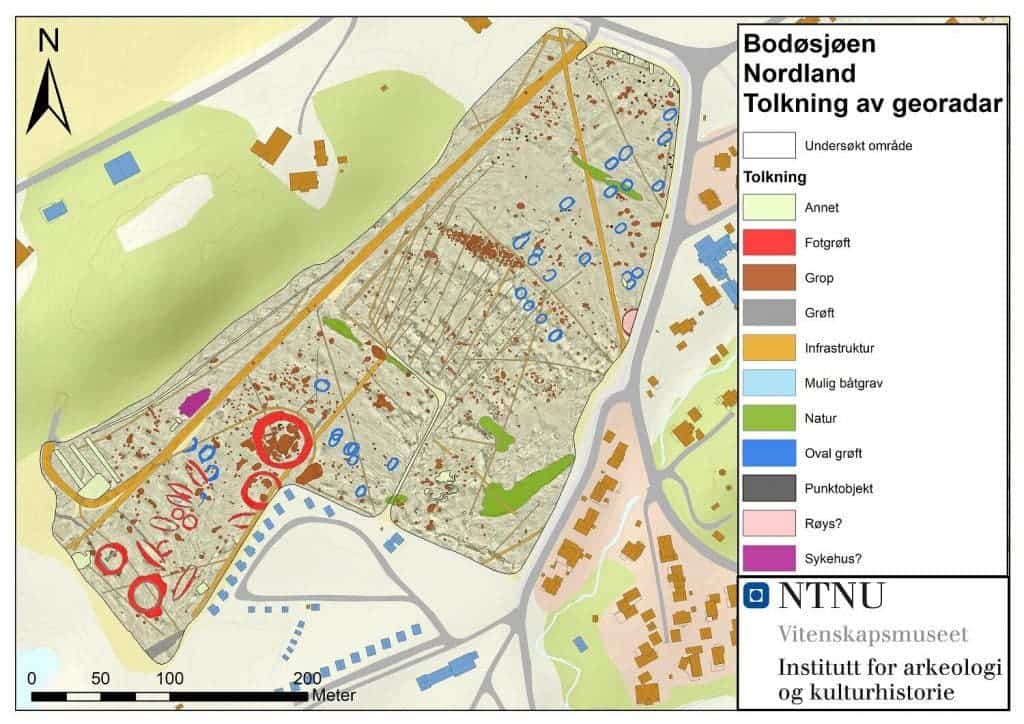
It’s not too often that archaeological research involves driving a four-wheeler across a frozen field, but in November 2019, that’s exactly what Arne Anderson Stamnes found himself doing. Stamnes is an archaeologist at NTNU University Museum, and he was using a ground-penetrating radar to survey the area.
Nowadays, archaeologists prefer to not dig randomly and carry out surveys such as this one to “see” the subsurface and learn where the interesting objectives are — and in the field Stamnes was looking, there was plenty of interesting stuff.
“Our findings included traces of 15 burial mounds, and one of them appears to contain a boat grave. Both the size and design of the burial mounds are typical of the period 650 to 950 CE—that is, what we call the Merovingian Period and Viking Age,” says Stamnes.
“A lot of the mounds are big. The largest burial mound has an inner dimension of 32 meters and must have been a towering presence in the landscape,” he adds.

It was an excellent set of findings, partially aided by the environmental conditions. Ground-penetrating radar sends electromagnetic waves into the subsurface, from which they are reflected back to a receiver. Since archaeological objects have different electromagnetic properties than the surrounding soil, these waves are reflected differently, betraying the position of the objective. It’s a bit like an X-Ray of the underground. The four-wheeler Stamnes was driving towed such a radar that swept the area. The presence of snow also made the conditions excellent for this type of survey.
“The results are astonishingly good and they whet your appetite for more,” says Nordland county archaeologist Martinus A. Hauglid.
The burial mound that Stamnes mentions is one of the largest in the region, and must have belonged to an important chief. But archaeologists were even more intrigued by something else: an ever-so-small mysterious structure. Or rather, many of them.
Ditches, ditches everywhere
The survey revealed no fewer than 1257 pits of various sizes. Which begs the question: what exactly are they?
It’s hard to say for sure, also because they’re probably not one thing, but rather multiple things — from cooking pits to post holes to garbage pits. But what they do confirm is that this was a very active area.
“I’ve asked a few of my colleagues, but so far haven’t found anything similar to this find in other excavations. So it’s difficult to conclude what it might be,” Stamnes says.
“The shape and the fact that most of the ditches have a clear orientation with the short end towards the sea—probably also the dominant wind direction—make it likely that this was a type of house foundation,” he said.
This also seems to fit with the theory that the site was an old Viking power center. We already know that a powerful family lived in the area (based on the burial mounds), and there was a lot of activity (as evidenced by the pits), but more evidence is needed before any clear conclusions can be drawn.
“What we can say is that these pits are another sign that this area has been packed with human activity,” says Stamnes.

The site also showcased another interesting aspect: Eight of the burial mounds are circular in shape, while seven are oblong. Oblong burial mounds are associated with female burial, so there seems to be a pretty good gender balance in the area.
“Five of the round grave monuments have a diameter greater than 17.5 meters, where the largest measures about 32 meters. The long mounds are between 17.7 and 29 meters long,” Stamnes says.
“Building such large tombs is resource-intensive, so it’s plausible that the people buried here had great power and influence, both locally and regionally,” he says.
Hauglid is also thrilled, as is Ingrid Nøren, the manager for the New City—New Airport project in Bodø municipality.
“Bodøgård was the seat of the sheriff—and later the county governor—in the Nordland region from the beginning of the 17th century, while Bodin church nearby is a stone church from the Middle Ages. The burial ground that has now been discovered testifies that a political-religious power center has existed here since the Late Iron Age,” says Hauglid.
“A new city quarter has given us the chance to explore an area we’ve long been curious about. We can even see from aerial photos that there’s something under the ground. The findings from the investigation have yielded a long-awaited and exciting mystery,” concludes Nøren.
The findings are discussed in an online report (in Norwegian).


